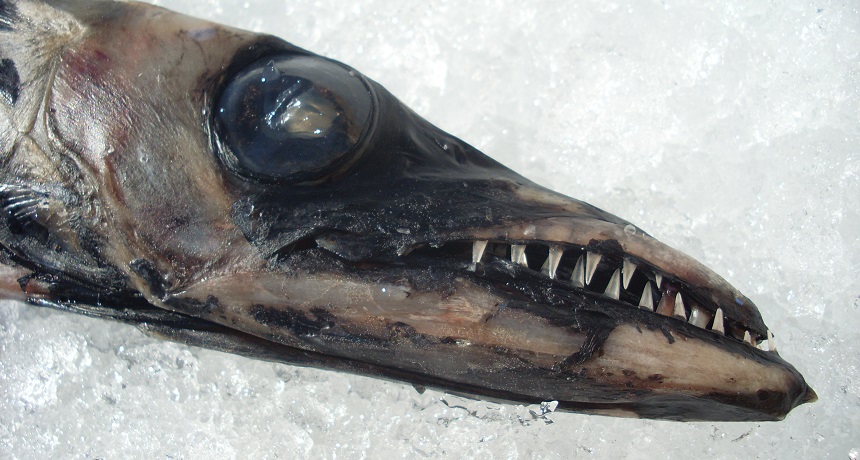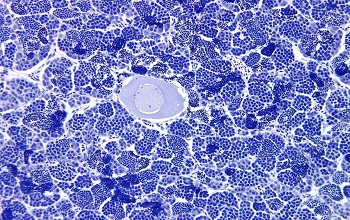Deep-sea fish show signs of exposure to pollution
Study suggests industrial chemicals may be causing tumors

This odd fish is a black scabbardfish (Aphanopus carbo). It is one of several deep-water species with health problems that may be related to pollution.
Brian Suda/Flickr (CC BY-SA 2.0)
Far below the ocean’s surface is a dark, mysterious world. There, it’s too deep for the sun’s rays to penetrate. Very few people have seen this world. Even fewer have studied the health of its inhabitants — oddly named fish such as the greater forkbeard, black scabbardfish and orange roughy.
Though hidden, these strange creatures still are part of our world. After all, people eat these and other deep-sea species. Now, a study finds some of these fish appear to be falling ill and that pollution may be the culprit. If true, eating these fish could expose people to the same pollution.
Changes in the internal organs of deep-sea fish resemble those seen in shallow-water fish exposed to human pollutants. These pollutants include heavy metals and industrial chemicals, such as PCBs.
“In areas ranging from pristine, high-mountain lakes of the United States to ocean waters off the coasts of France and Spain, we’ve now found evidence of possible human-caused pollution,” says Michael Kent. He’s an expert on fish disease who works at Oregon State University in Corvallis.
His team’s new study could not confirm what caused the inflammation, liver damage and other problems seen in fish netted deep in the Atlantic Ocean. However, Kent notes, the types of harm seen in these deep-sea fish resemble what’s usually seen in animals exposed to cancer-causing pollutants and other toxic chemicals.
His group described the evidence of disease in these fish in the May 2015 issue of Marine Environmental Research.
What they saw
As a fish pathologist, Stephen Feist studies diseases in fish. Also an author of the new study, he works at the Centre for Environment, Fisheries and Aquaculture Science in Weymouth, England. By understanding what ails fish, he hopes to protect others from a similar fate. And the subtle impacts seen in the fish surveyed as part of the new study left him disturbed.

“A wide variety of inflammatory and degenerative lesions were found in all species examined,” the team reports. Inflammation is one way the body responds to injury. It’s not a healthy sign. Similarly, degenerative changes signal injury to a tissue from disease or trauma.
None of the fish had visible tumors. But the researchers did see telltale signs that tumors may be starting to develop. These showed up when the scientists looked at cells in the fishes’ livers.
Additional concerns
The researchers turned up one fish with what scientists call “intersex characteristics.” This means it showed signs of being both male and female. Only females should make eggs. But one of the male fish also was developing eggs.
Certain chemical pollutants can trigger such changes by mimicking or altering the action of the body’s hormones, important signaling agents. Such hormone-like pollutants are known as endocrine disruptors. That is because these pollutants alter the normal action of the hormonal — or endocrine — system.
Feist says scientists would need to catch many more deep-water fish with this condition before they could say whether intersex fish are common in the deep sea. But such changes have become common in the fish of many polluted rivers and lakes.
If pollution is causing the ailments showing up in deep-sea fish, eating those fish could transfer the pollutants to the diner. And that could be us. Indeed, overfishing of coastal waters has encouraged many fleets to begin fishing deeper waters.
And deep-sea fish may become a sort of accidental magnet for pollutants, notes Brett Lyons. Like Feist, he works at the Centre for Environment, Fisheries and Aquaculture Science. However, Lyons was not involved in the study. Lyons studies how chemical pollutants harm animals. Deep-water fish tend to live longer than those near the surface. This gives them longer to “accumulate more chemical pollutants,” he explains. And that, he notes, “is important to know if we start targeting these fish as a food [for people].”
Right now, Lyons says, biologists “know lots about how pollution impacts the marine life on our beaches or close to the coast, but very little about how it may harm those animals living in the very deepest parts of our oceans.” And that’s what makes the study so potentially important, he says.
Feist and his team emphasize that while the fish problems they describe look like pollution poisoning, they can’t be sure. The same changes also might be caused by naturally occurring poisons in the ocean. One type, known as microcystins, are toxins produced by algae.
Scientists would have to analyze chemicals in the fish before knowing for sure if human pollution was behind the animals’ health problems. Feist and his team hope to do that soon.
Power Words
(for more about Power Words, click here)
endocrine disruptor A substance that mimics the action (sometimes well, sometimes poorly) of one of the body’s natural hormones. By doing this, the fake hormone can inappropriately turn on, speed up or shut down important cellular processes.
gonad An organ that produces gametes. Gametes sexual reproductive cells, such as a sperm or egg, that unites with another cell to form a new organism.
hormone (in zoology and medicine) A chemical produced in a gland and then carried in the bloodstream to another part of the body. Hormones control many important body activities, such as growth. Hormones act by triggering or regulating chemical reactions in the body.
inflammation The body’s response to cellular injury and obesity; it often involves swelling, redness, heat and pain. It is also an underlying feature responsible for the development and aggravation of many diseases, especially heart disease and diabetes.
intersex Animals or humans that display characteristics of both male and female reproductive anatomy.
lesion A tissue or part of the body that shows damage from injury or disease. Lesions come in all shapes and sizes, both inside the body and on its outside. A pus-filled wound on the skin is one example. Cells with holes in them or missing parts due to disease represent a totally different class of lesions.
liver An organ of the body of animals with backbones that performs a number of important functions. It can store fat and sugar as energy, breakdown harmful substances for excretion by the body, and secrete bile, a greenish fluid released into the gut, where it helps digest fats and neutralize acids.
marine Having to do with the ocean world or environment.
microcystins A class of toxins produced by some algae. Most of these toxins work by poisoning the liver.
organ (in biology) Various parts of an organism that perform one or more particular functions. For instance, an ovary is an organ that makes eggs, the brain is an organ that interprets nerve signals and a plant’s roots are organs that take in nutrients and moisture.
pathologist Someone who studies disease and how it affects people or other infected organisms.
pollutant A substance that taints something — such as the air, water, our bodies or products. Some pollutants are chemicals, such as pesticides. Others may be radiation, including excess heat or light. Even weeds and other invasive species can be considered a type of biological pollution.
polychlorinated biphenyls (or PCBs) A family of 209 chlorine-based compounds with a similar chemical structure. They were used for many decades as a nonflammable fluid for insulating electrical transforms. Some companies also used them in making certain hydraulic fluids, lubricants and inks. Their production has been banned in North America and many countries throughout the world since around 1980.
subtle Some feature that may be important, but can be hard to see or describe. For instance, the first cellular changes that signal the start of a cancer may be visible but subtle — small and hard to distinguish from nearby healthy tissues.
testis (plural: testes) The organ in the males of many animal species that makes sperm, the reproductive cells that fertilize eggs. This organ also is the primary site that makes testosterone, the primary male sex hormone.
toxin A poison produced by living organisms, such as germs, bees, spiders, poison ivy and snakes.
trauma Serious injury or damage to an individual’s body or mind.
tumor A mass of cells characterized by atypical and often uncontrolled growth. Benign tumors will not spread; they just grow and cause problems if they press against or tighten around healthy tissue. Malignant tumors will ultimately shed cells that can seed the body with new tumors. Malignant tumors are also known as cancers.







